- Submissions

Full Text
Peer Review Journal of Solar & Photoenergy Systems
Grid-Connected Photovoltaic System Requirement
Tarek Selmi1* and Adel Gastli2
1Department of Electrical and Mechatronics Engineering, Sohar University, Oman
2Department of Electrical Engineering, Qatar University, Qatar
*Corresponding author: Tarek Selmi, Department of Electrical and Mechatronics Engineering, Sohar University, Oman, Tel: (+968) 68501; Email:tselmi@soharuni.edu.om
Submission: September 05, 2018;Published: September 17, 2018

Abstract
This paper presents an extensive exploration of grid-connected photovoltaic installations in the Sultanate of Oman. It aims at sizing a 5kWp solar power station at Sohar University (SU). It reflects the impact of tilt angle adjustment on the amount of extracted power in the mentioned location. Moreover, the paper presents an approach to match PV modules to the right inverter to avoid unwanted losses. It also presents a techno-financial study for consumers as well as for experts in the field towards the investigation of grid-connected PV installations. The data presented within this paper has been prepared using PVsyst 6.6.3 software tool, which integrates the simulation of a PV system with evaluation of its pre-feasibility, sizing and financial analysis.
Keywords: Tilt angle; Photovoltaic; Inverter; Balance of system; PV module
Introduction
A recent 7-year statement (2017-2023) published by Oman power and water procurement company (OPWP) [1], states that peak demand will probably grow at about 6% per year, from 5,920MW in 2016 to 8,960MW in 2023.This growth rate, which is lower than its previous forecasts, reflects the country economic trends to introduce cost reflective tariffs to large consumers. As part of its plan between 2017 and 2023, the company is preparing the necessary logistics and infrastructure for a growth in energy demand of 5%, which leads to a minimum demand in energy of around 8,310MW.
In terms of fuel requirements, OPWP predicts the growth to be limited at 3% per year through 2023, despite 7% growth in electricity production. Moreover, the amount of gas used by the generation fleet will most likely improve by 28% through the same period [1,2].
To overcome such challenges, the Authority of Electricity Regulation in Oman (AER) is significantly depending on solar and wind power sources. In fact, AER is planning to setup more residential grid-connected solar power generation systems to save around 2 to 6 billion standard cubic meter (Sm3) of gas over the next 25 years, which is the equivalent of savings almost 161 to 505 million Real Omani ($416.84mn to $1307.49mn), respectively. AER believes that the adoption of residential small-scale grid-connected solar PV systems could also reduce nearby 3.2 to 10 million tons of CO2 emission over the next 25 years and a drop in the annual consumer bill by at least 34% to 42% [3,4].
There are mainly two types of electrical designs for PV energy systems. Grid connected systems that interact with the utility power grid and do not require battery backup capabilities; and standalone systems that require battery backup. Although the first type is supposed to shut down when there is no sun shining, it will normally provide the highest amount of bill savings. Recently, it became not essential to size the grid-connected PV system to exactly match the daily needs of the consumer. In fact, while the PV system is silently generating green power, the grid is always available. When the green power generated is greater than the consumer need, the excess of power is fed back into the grid. However, when the PV system does not produce enough power, the grid will supply the consumer with power, which eliminates the need for battery storage and provides less system maintenance and more saving to the consumers [5].
To design a grid-connected PV system in a specific location, some variables and parameters have to be considered. In fact, the adjustment of the tilt angle all over the year seasons is a matter of great concern for the sake of higher energy production. Moreover, the type of the PV modules used within the PV system should be chosen appropriately. Matching the peak power generated from the PV modules to the right DC-AC inverter size is also a critical concern to avoid unwanted losses. In addition to the previously listed considerations, the impact of some environmental parameters such as the irradiation level and the temperature on the PV system performance should be well addressed within a PV cell electrical model [6-10].
Optimum Tilt Angle
The optimization of tilt angle for PV systems is a matter of great importance [11-15]. Theoretically, the maximum output energy from a PV cell is obtained when the surface of the PV module is oriented directly perpendicular to the sun’s rays. However, when it comes to practice, this is not at all true because when the sun is perpendicular to the surface of the PV module, the temperature of the module increases significantly, which is inversely proportional to the module’s efficiency. Accordingly, adjusting the tilt angle is important to maximize the output power at any given situation. The optimum tilt angle depends on the latitude as well as on the climate conditions [16]. In [17], the authors conducted a study on the optimum tilt angle in Oman through the four seasons and found that the optimum tilt angle is at 49° in the period from 21st of September to the 21st of March, while it must be zero during the rest of the year. In [18], an algorithm has been developed and implemented in MATLAB to vary the tilt angle from -20° to +90° in 1° step for each day of the year. The code is since the amount of solar energy incident on a solar collector is the sum of beam, diffuse and ground reflected radiation. Such powerful code found that the tilt angle in Jeddah for example lies between -15 to +51 towards the south. A general recommendation was given by [19], which states that the maximum annual solar energy from arrays on a fixed surface is achieved by orienting the surface at a tilt angle nearly the same as the value of the local latitude. This is true somehow and will be explained next. In another context, several studies on PV systems located in Europe and in North America have shown that average soiling loss is tilt-dependent. In fact, they reported that almost 6% losses a year for horizontal or low tilted PV generators and 2% losses a year for PV generators tilted at optimum angle (about 30 degrees) [20]. In its report published on May 2017, the Oman AER claims that the favorable orientation (azimuth) for fixed solar cells in the Sultanate of Oman throughout the year is South (0°S) with a tilt angle ranging between 20° (Salalah) to 24° (Muscat) with respect to the horizontal plane [21].
Figure 1: Location of Sohar university.
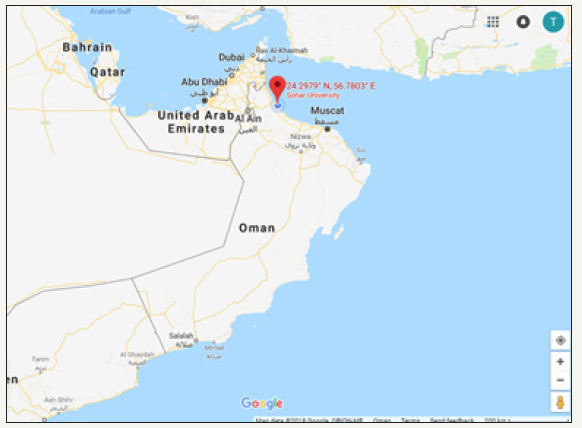
Figure 2: Recommended optimum tilt of 42º (for october-march) at SU.
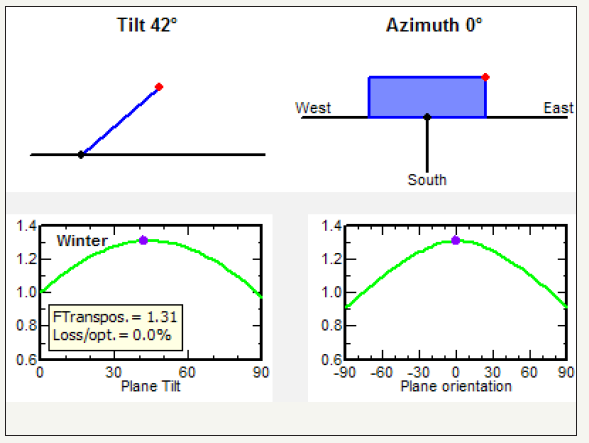
Figure 3: Recommended optimum tilt of 10º (april-september) at SU.

Sohar University is located at 24.2979°N, 56.7803°E as shown in Figure 1 where the tilt angle has been investigated using PVsyst 6.6.3 with incredibly accurate climatic data taken from Meteonorm 7.1 over two different periods: Winter (October to March) and Summer (April to September). Figure 2 shows that for the first period, the maximum power is guaranteed for a tilt of 42° for which the loss resulting from the optimization is 0%. Therefore, 42° seems to be the most excellent tilt angle during winter. Likewise, the optimum tilt is at 10° during summer period as shown in Figure 3.
Based on the above analysis, there will be always at least two tilt angles to be considered: one during summer and another during winter periods. However, this is realistic only in lab scale. In fact, technically speaking, simple consumers are not yet mature enough to bother themselves by adjusting the tilt angle twice or even more a year. Accordingly, an optimized tilt for fixed PV systems on roofs or even in desert seems to be essential and critical. Figure 4 shows the recommended yearly optimum tilt of 30° at the mentioned location for fixed PV systems where the loss resulting from optimizing the tilt is 0% and a transport factor around 1.0.
Figure 4: Recommended optimum tilt of 10º (april-september) at SU.
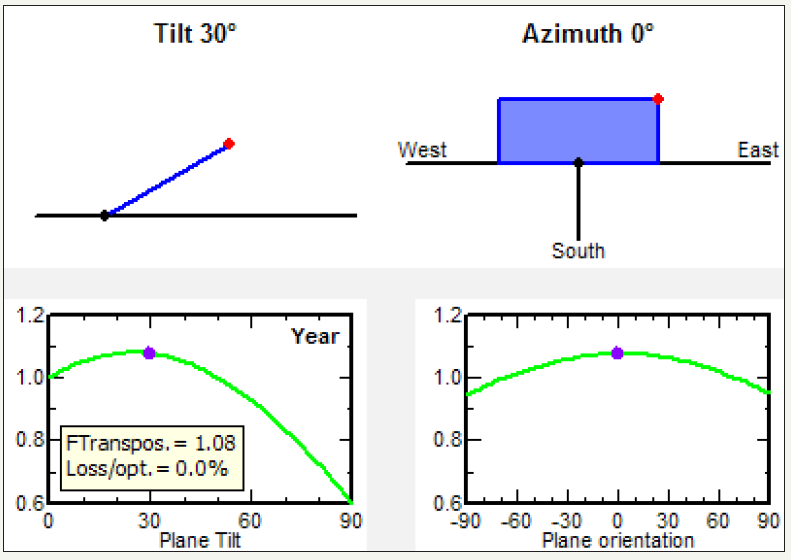
Grid-Connected PV Systems Analysis
Grid-connected PV systems, which do not require battery storage, are gaining more attention from electricity authorities all over the world [21-35]. The rapid growth of energy demand in Oman during the last decade drew the attention of public authorities to encourage small-scale residential grid-connected PV systems. In this context, the pre-feasibility of a grid-connected PV system at SU seems to be a fruitful step. In fact, installing a grid-connected PV system is not just connecting PV modules to an inverter and simply getting electricity. It requires a lot of effort and expertise to choose the right PV module technology suitable to the Omani climate, to match the output voltage of the PV array to the inverter, to consider losses, etc.
PV Module Selection and Performance Analysis
Table 1: Overview of available PV modules in the market.
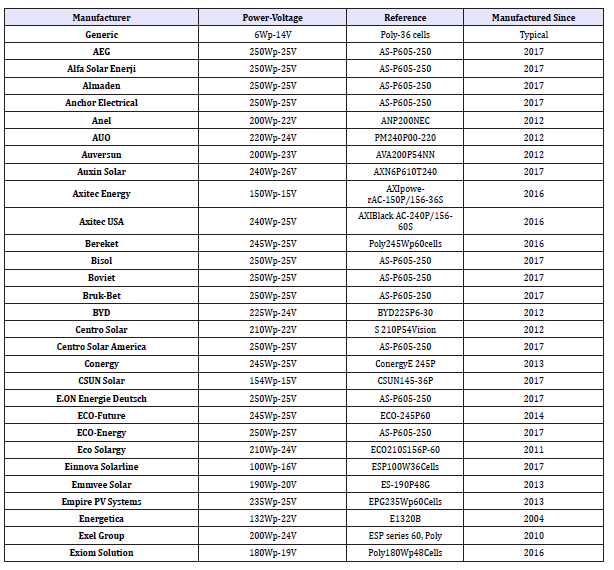
Table 1 presents most famous PV modules available in the market along with their manufacturing references. The PV module selected for the PV system sized at SU is AEG AS-P605-250. The selection was based on the output power/voltage. In fact, as shown in the Table, the selected PV module has the highest output power and voltage respectively. Note that the data given in the table is provided by the manufacturers and is measured under Standard Test Condition (STC) at a temperature of 25 °C and an incident irradiation of 1000W/m2.
DC-AC Converter (Inverter)
The DC-AC converter or inverter is the most important component within a PV conversion system. Nowadays, so many inverter topologies have been developed and are commercially available [36-38]. Obviously, inverters are available with different power ratings depending on the consumers’ needs. However, matching the inverter input to the output voltage/current/power of the PV array is not always an easy task. Mainly, when designing a PV system, the designer, upon the consumer need, is supposed to award a special care to the following points:
- Number of strings.
- Number of PV modules and their semiconductor type.
- The area to install the PV modules.
- The maximum operating power at 1000W/m2 and 50 °C (kW).
- The most suitable inverter/inverters matching the consumer need.
Table 2 presents an attempt, for many commercially available inverters so far and for the PV module AEG (AS-P605-250), to fulfill the above listed points. In view of that, one of the below situations could occur:
Table 2: Commercial DC-AC inverters for power ≤5KWp.
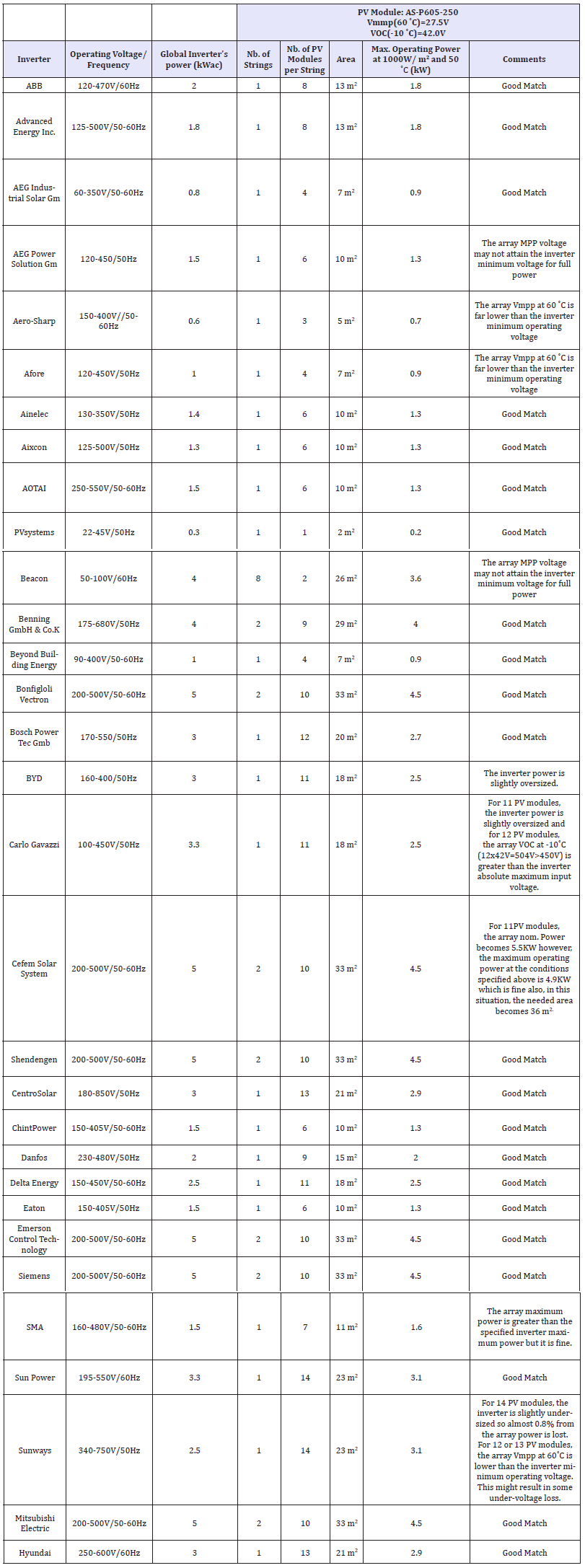
- Good match between the inverter and the PV array.
- The array MPP voltage may not attain the inverter minimum voltage for full power.
- The array Vmpp at STC is far lower than the inverter minimum operating voltage.
- The inverter power is slightly oversized.
- The inverter power is slightly undersized.
- The array maximum power is greater than the specified inverter maximum power.
Figure 5: Efficiency of the shendengen (PVS005T200) inverter.
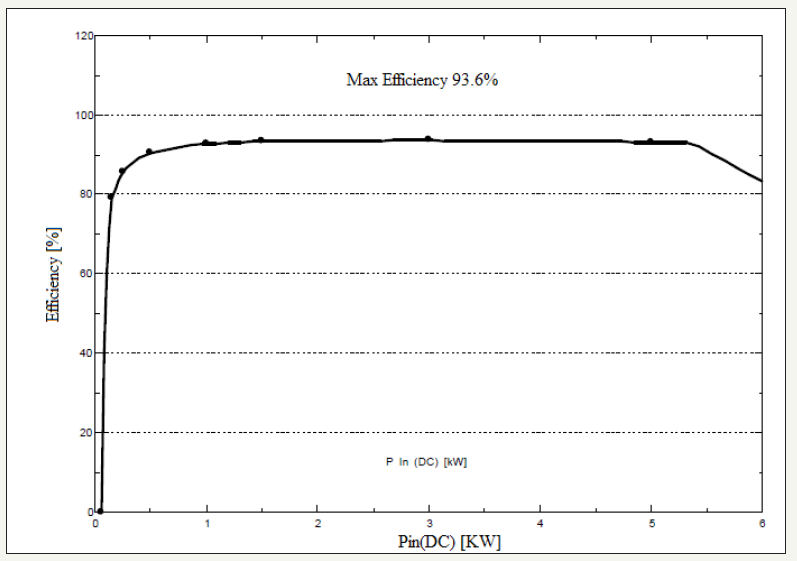
For the case study at SU, a 5kWp PV system is to be sized. To do so, the inverter selected is Shendengen (PVS005T200). Such inverter has a maximum efficiency around 93.6% as shown in Figure 5. The chosen inverter presents a good match when connected to two strings of ten PV modules AEG (AS-P605-250) each. It is essential to know that a PV system sized at 5kWp is not supposed to produce such amount of power constantly. In fact, several losses due to different parameters have to be considered. The loss diagram shown in Figure 6 classifies these losses under the following categories:
Figure 6: Efficiency of the shendengen (PVS005T200) inverter.

- Loss due to the temperature.
- Loss due to the incident irradiation level.
- Loss due to the PV module quality.
- Loss due to mismatch phenomenon between strings.
- Ohmic loss due to wiring.
- Loss at the inverter level due to its efficiency and its operation.
Energy balance of the PV system at SU
Table 3: Energy balance over a whole year.

Table 4: System and net production after losses deduction over one year.

Based on the previous analysis and for the PV system sized at SU, Table 3 shows the energy balance of the system over one year, while Table 4 estimates the price of one kWh of electricity accordingly. In fact, the analysis shows that, for the studied case, the electricity will cost 0.14€/kWh (0.064OMR). This cost might be higher than the current subsidized electricity price (0.01OMR) but for sure it won’t be the same situation after several years as electricity price is getting higher and PV panels are getting cheaper year after year. The analysis assumes that the PV system is funded through a loan with 5% interest rate for a period of 20 years.
Conclusion
This paper has reviewed the main issues related to grid connected PV system design and implementation through a typical case study of a 5kWp PV installation at SU. The analysis has demonstrated and validated the effect of different manufacturing and environmental parameters on the design and performances of the PV system. The appropriate PV panels and their matching inverter were selected. PVsyst was used to conduct a thorough analysis of the complete system design and performance. It was found that the optimum tilt angle for fixed PV modules installation at SU location is 10°. Besides, an economic analysis of the whole system was conducted. Even though the cost of kWh produced by the PV system was estimated and found still higher compared to the currently subsidized price, the situation may change significantly in the near future with the increase of fuel prices and decrease of the cost of PV systems.
References
- http://www.omanpwp.com/PDF/OPWP7YearsStatementIssue1120172023Eng. pdf.
- http://www.omanpwp.com/PDF/OPWP-7YS English 2016.pdf
- http://www.omanpwp.com/PDF/opwp_7yr_eng.pdf
- http://www.omanpwp.com/PDF/OPWP_7 Year Statement 2014 English.pdf
- Gastli A, Armendáriz JSM (2013) Challenges facing grid integration of renewable energy in the GCC region. Gulf Research Center, Switzerland, pp. 1-21.
- Obi M, Bass R (2016) Trends and challenges of grid-connected photovoltaic systems-A review. Renewable and Sustainable Energy Reviews 58: 1082-1094.
- Alam HM, Hawila D, Kennedy S, Mezher T (2016) The GCC countries RE-readiness: Strengths and gaps for development of renewable energy technologies. Renewable and Sustainable Energy Reviews 54: 1114- 1128.
- Bhattacharya M, Paramati SR, Ozturk I, Bhattacharya S (2016) The effect of renewable energy consumption on economic growth: Evidence from top 38 countries. Applied Energy 162: 733–741.
- Kolhe M, Ranaweera I, Gunawardana BS (2015) Techno-economic sizing of off-grid hybrid renewable energy system for rural electrification in Sri Lanka. Sustainable Energy Technologies and Assessments 11: 53–64.
- Khare V, Nema S, Baredar P (2016) Solar–wind hybrid renewable energy system: A review. Renewable and Sustainable Energy Reviews 58: 23– 33.
- Al-Shamani AN, Othman MYH, Mat S, Ruslan MH, Abed AM, et al. (2015) Design & sizing of stand-alone solar power systems a house Iraq. Recent Advances in Renewable Energy pp: 145-150.
- Tripathy M, Yadav S, Sadhu PK, Panda SK (2017) Determination of optimum tilt angle and accurate insolation of BIPV panel influenced by adverse effect of shadow. Renewable Energy Vol. 104.
- Hartner M, Ortner A, Hiesl A, Haas R (2015) East to west-The optimal tilt angle and orientation of photovoltaic panels from an electricity system perspective. Applied Energy 160: 94-107.
- Lau KY, Tan CW, Yatim AHM (2018) Effects of ambient temperatures, tilt angles and orientations on hybrid photovoltaic/diesel systems under equatorial climates. Renewable and Sustainable Energy Reviews 81: 2682-2636.
- Orioli A, Gangi AD (2013) Load mismatch of grid-connected photovoltaic systems: Review of the effects and analysis in an urban context. Renewable and Sustainable Energy Reviews 21: 13-28.
- Abdeen E, Orabi M, Hasaneen ES (2017) Optimum tilt angle for photovoltaic system in desert environment. Solar Energy 155: 267-280.
- Kazem HA, Khatib T, Alwaeli AAK (2013) Optimization of photovoltaic modules tilt angle for Oman. Proceedings of IEEE 7th International Power Engineering and Optimization Conference (PEOCO), pp. 703-707.
- Kaddoura T, Ramli MAM, Al-Turki YA (2016) On the estimation of the optimum tilt angle of PV panel in Saudi Arabia. Renewable and Sustainable Energy Reviews 65: 626-634.
- Babatunde AA, Abbasoglu S, Senol M (2018) Analysis of the impact of dust, tilt angle and orientation on performance of PV Plants. Renewable and Sustainable Energy Reviews 90: 1017-1026.
- Dolara A, Leva S, Manzolini G (2015) Comparison of different physical models for PV power output prediction. Solar Energy 119: 83-99.
- Jaalam N, Rahim NA, Bakar AHA, Tan CK, Haidar AMA (2016) A comprehensive review of synchronization methods for grid-connected converters of renewable energy source. Renewable and Sustainable Energy Reviews 59: 1471-1481.
- Busaidi ASA, Kazem HA, Badi AH, Khan MF (2016) A review of optimum sizing of hybrid PV–wind renewable energy Systems in Oman. Renewable and Sustainable Energy Reviews 53: 185-193.
- Modi A, Bühler F, Andreasen JG, Haglind F (2017) A review of solar energy-based heat and power generation systems. Renewable and Sustainable Energy Reviews 67: 1047-1064.
- Li DHW, Cheung KL, Lam TNT, Chan WWH (2012) A study of gridconnected photovoltaic (PV) system in Hong Kong. Applied Energy 90: 122-127.
- Sreedevi J, Ashwin N, Raju MN (2016) A study on grid connected PV system. National Power Systems Conference (NPSC), India, 19-21.
- Bicer Y, Dincer I (2016) Analysis and performance evaluation of a renewable energy based multigeneration system. Energy 94: 623-632.
- Lin B, Li J (2015) Analyzing cost of grid-connection of renewable energy development in China. Renewable and Sustainable Energy Reviews 50: 1373-1382.
- AlHatmi Y, Tan CS, Al Badi A, Charabi Y (2014) Assessment of the consciousness levels on renewable energy resources in the Sultanate of Oman. Renewable and Sustainable Energy Reviews 40: 1081-1089.
- Lu Y, Wang S, Shan K (2015) Design optimization and optimal control of grid-connected and standalone nearly/net zero energy buildings. Applied Energy 155: 463-477.
- Albadi MH (2017) Electricity sector in Oman after 10 years of reform: Status, trends, and future perspectives. The Electricity Journal 30: 23-30.
- Nematollahi O, Hoghooghi H, Rasti M, Sedaghat (2016) A Energy demands and renewable energy resources in the Middle East. Renewable and Sustainable Energy Reviews 54: 1172-1181.
- Kazem HA (2015) Feasibility of photovoltaic systems in oman. First Workshop on Smart Grid and Renewable Energy (SGRE), Qatar.
- Benabdallah I, Oun A, Cherif A (2017) Grid connected PV plant based on smart grid control and monitoring. (IJACSA) International Journal of Advanced Computer Science and Applications 8(6).
- Kesraoui M, Lazizi A, Ghaib A (2016) Grid connected solar PV system: modelling, simulation and experimental tests. Energy Procedia 95: 181- 188.
- Albadi MH, El-Rayani YM, El-Saadany EF, Al-Riyami HA (2018) Impact of solar power projects on LMP and transmission losses in Oman. Sustainable Energy Technologies and Assessments 27: 141-149.
- Selmi T, Bouzguenda M, Gastli A, Masmoudi A (2012) A novel transformerless inverter topology without zero-crossing distortion. International Journal of Renewable Energy Research-IJRER 2(1): 140- 146.
- Selmi T, Bouzguenda M, Gastli A, Masmoudi A (2015) Microcontrollerbased inverter topology integrated in PV systems. The International Journal for Computation and Mathematics in Electrical and Electronic Engineering 34(1): 132-150.
- Selmi T, Bouzguenda M, Gastli A, Masmoudi A (2012) Transformerless microinverter for photovoltaic systems. International Journal of Energy and Environment 3(4): 639-650.
© 2018 Tarek Selmi. This is an open access article distributed under the terms of the Creative Commons Attribution License , which permits unrestricted use, distribution, and build upon your work non-commercially.
 a Creative Commons Attribution 4.0 International License. Based on a work at www.crimsonpublishers.com.
Best viewed in
a Creative Commons Attribution 4.0 International License. Based on a work at www.crimsonpublishers.com.
Best viewed in 







.jpg)






























 Editorial Board Registrations
Editorial Board Registrations Submit your Article
Submit your Article Refer a Friend
Refer a Friend Advertise With Us
Advertise With Us
.jpg)






.jpg)














.bmp)
.jpg)
.png)
.jpg)










.jpg)






.png)

.png)



.png)






